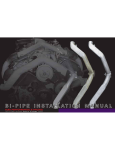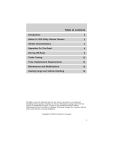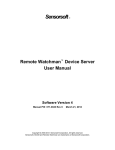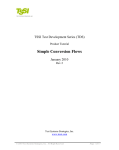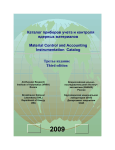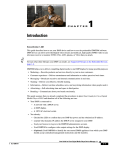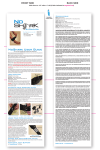Download March 31, 2009
Transcript
Operating Experience Summary f U.S. Department of Energy Office of Health, Safety and Security OE Summary 2009-03 March 31, 2009 Inside This Issue • Trackhoe Tips Over from Momentum of Rapidly Swinging Boom..................1 • NRC Identifies Concerns with Biodiesel Use in Diesel Engines Used for Safety..................................4 • Preventing Power Tool Injuries...........6 Operating Experience Summary Issue Number 2009-03, Article 1: Trackhoe Tips Over from Momentum of Rapidly Swinging Boom Trackhoe Tips Over from Momentum of Rapidly Swinging Boom On September 11, 2008, at Pacific Northwest National Laboratory (PNNL), a contractor trackhoe operator was clearing tumbleweed from a spoils pile when the trackhoe tipped over on its side. The trackhoe was equipped with rollover protection, and the operator was wearing his seatbelt, safety glasses, and a hardhat. Damage to the trackhoe was minor, and the worker received only a minor cut to his hand. (ORPS Report SC--PNSO-PNNLPNNLBOPER-2008-0020; final report issued October 24, 2008) The operator was maneuvering the trackhoe between the edge of the spoils pile and a fence located on the boundary of the work site. The distance between the fence and the spoils pile was quite narrow (i.e., barely the width of the trackhoe tracks), so the operator had to position the trackhoe with one of its tracks elevated approximately 1.5 feet above the other. The operator had only about 15 minutes left in his shift, and only a few more feet of brush to clear, so he decided on his own initiative, and without informing his supervisor, to drive the trackhoe to the west side of the pile and remove brush there. The operator had to raise the trackhoe boom nearly to its full extent to reach the brush located on the upper portion of the spoils pile. After he picked up the brush, he rapidly swung the boom to drop it on the other side of a fence. The rapid swinging of the boom apparently caused enough momentum to tip the trackhoe over. Office of Health, Safety and Security download this article Investigators learned that extra attachments had been installed on the boom of the rented trackhoe. They believe that the extra weight on the boom from the attachments, the slight tilt that caused one set of tracks to sit 1.5 feet higher than the other, and the rapid swinging of the boom created enough momentum to cause the trackhoe to tip over. Figure 1-1 shows the trackhoe on its side, and Figure 1-2 shows a mobile crane setting it upright following the accident. Investigators deter mined that the operator was working outside the approved work scope and rushing to complete a work task. The ensuing operator error resulted in the equipment being placed into a configuration that was not within safe operating parameters. Figure 1-1. Trackhoe on its side post-event The contractor was required to address this event by developing a plan that responded to management concerns and included information about how they will impose better work controls, including the following. • Identifying equipment limitations and communicating them to workers before work begins. • Documenting on-the-job evaluations of equipment operators before they begin work. • Developing pre-job planning with hazard recognition and mitigation. Page 1 of 8 March 31, 2009 Operating Experience Summary Issue Number 2009-03, Article 1: Trackhoe Tips Over from Momentum of Rapidly Swinging Boom • Demonstrating how adequate field supervision will be provided for each task. A similar event occurred at Idaho National Laboratory on June 30, 2007. In that event, a vibratory compactor being used to compact soil over a fire-main line tipped over as the operator tried to drive it down the centerline of a 4-foot berm. As the compactor reached the peak of the berm, it began to slide sideways and then tipped over on its side. The operator was wearing his seatbelt and was not injured. (ORPS Report EM-ID-CWI-RWMC-2007-0009; final report issued September 13, 2007) Operator error also contributed to this event. Investigators determined that the operator had limited experience with the equipment and had not operated any similar equipment in over 20 years. They also determined that job scoping did not identify download this article any special conditions and that the Job Safety Analysis did not identify the hazard of operating the equipment on a sloped surface. Investigators also learned in interviews that the pre-job briefing “generated confusion about the allowable work for that day.” In addition, the supervisor was responsible for covering work by several operators in different areas and was unable to watch the higher hazard work being performed by the compactor operator. Lessons learned identified in the ORPS report for this event are also applicable to the PNNL event; specifically, that “knowledge, skills, training, strong two-way communication, and experience all play a part in the safe completion of work.” An OE Summary article entitled Inadequate Work Planning Results in Heavy Equipment Accidents, published in OE Summary 2004-15, reported on a number of accidents involving heavy duty equipment that occurred across the DOE Complex in 2004. In each of the events discussed, thorough pre-job planning with specific work packages might have prevented the accident. The events also showed the need for operators to react quickly to changing conditions. OE Summary 2005-14, Article 3, provides details on a scraper tipover at Fernald on April 20, 2005, and outlines good practices when operating heavy equipment, including wearing seatbelts. OSHA requirements for material handling equipment in 29 CFR 1926.602 apply to earthmoving equipment, including scrapers, loaders, crawler or wheel tractors, bulldozers, offhighway trucks, graders, agricultural and industrial tractors, and similar equipment. Included are requirements for seat belts, rollover protection, ramps, and attachments. Figure 1-2. Mobile crane lifting trackhoe upright Office of Health, Safety and Security Page 2 of 8 March 31, 2009 Operating Experience Summary Issue Number 2009-03, Article 1: Trackhoe Tips Over from Momentum of Rapidly Swinging Boom download this article These events demonstrate why it is essential to stay within the scope of the task and why workers should not make unilateral decisions that could lead to a hazardous situation. They also show the importance of performing adequate hazard analyses that address all potential hazards, including any changes in routine processes. Two-way communication between workers and supervisors is essential to safety, and supervisors must clearly communicate the job scope and any hazards to workers. Care should be taken to ensure that supervisors are not so overloaded with conflicting tasks that they cannot properly supervise all work activities. Keywords: Near miss, trackhoe, tipover, boom ISM CORE FUNCTIONS: Define Scope of Work; Analyze the Hazards; Develop and Implement Hazard Controls; Perform Work within Controls Pin #4 Office of Health, Safety and Security Page 3 of 8 March 31, 2009 Operating Experience Summary Issue Number 2009-03, Article 2: NRC Identifies Concerns with Biodiesel Use in Diesel Engines Used for Safety NRC Identifies Concerns with Biodiesel Use in Diesel Engines Used for Safety On February 23, 2009, the Nuclear Regulatory Commission (NRC) issued Information Notice 2009-02, Biodiesel in Fuel Oil Could Adversely Impact Diesel Engine Performance. The purpose of the Notice is to alert licensees of nuclear power reactors and fuel cycle facilities to the potential for diesel fuel oil to contain up to 5 percent biodiesel (B5), which could adversely impact the performance of diesel engines used for facility safety. (NRC Information Notice 2009-02) Biodiesel is a domestic, renewable fuel for diesel engines derived from natural oils, such as soybean oil, or produced from used vegetable oils, such as recycled restaurant fryer oil. Biodiesel is represented by the letter “B” with the percentage of biodiesel contained in the blend as a numerical representation (e.g., B100 is pure biodiesel). Underwriters Laboratories, Inc. (UL) initiated a technical review of biodiesel fuel and technologies and worked closely with DOE, National Renewable Energy Laboratory, Brookhaven National Laboratory, Oak Ridge National Laboratory, and the National Biodiesel Board. The findings indicated that there were no adverse safety effects from the use of biodiesel fuel; however, UL acknowledged that introduction of biodiesel potentially can affect fuel quality by mobilizing contaminants in the fuel system or increasing the potential for microbial contamination. According to the Information Notice, on June 19, 2008, the American Society for Testing and Materials (ASTM) Inter national D02 Main Committee approved a revision to ASTM Office of Health, Safety and Security download this article D975-08a, Standard Specification for Diesel Fuel Oils, which permits No. 2 diesel fuel to contain up to a B5 blend without labeling the blend, while considering it to be the same fuel. This could result in petroleum fuel users receiving a B5 blend from their suppliers without being aware of it. The changes to this Standard are to take effect about 5 months after the October 13, 2008, publication date of the final Standard. The NRC is concerned with the potential generic applicability and common-cause failure issues associated with the introduction of biodiesel blends into No. 2 diesel fuel because of the potential adverse physical properties associated with biodiesel use in the following diesel engine applications. • Emergency diesel generators • Diesel-driven fire water pumps • Diesel-driven auxiliary feedwater pumps • Diesel-driven essential service water makeup pumps • Diesel-driven instrument air compressors • Security diesel generators • Safe shutdown facility diesel generators • Diesel generators for emergency preparedness • Station blackout diesel generators Although biodiesel blends of B5 or less do not cause noticeable differences in performance compared to No. 2 diesel fuel, B5 can have a cleaning effect that loosens accumulated sediment in fuel oil storage tanks that previously stored conventional diesel fuel. The sediment can then plug filters and other equipment in the fuel oil system. Licensees can expect to change or clean filters more frequently, especially during the early stages of B5 use. Page 4 of 8 March 31, 2009 Operating Experience Summary Issue Number 2009-03, Article 2: NRC Identifies Concerns with Biodiesel Use in Diesel Engines Used for Safety Biodiesel also contains suspended particles of water from the manufacturing process that will fall out of suspension and form “dirty water” in the fuel oil storage tank, which can lead to algae growth. Because B5 is also biodegradable, the presence of water, heat, oxygen, and other impurities accelerates the degradation of the fuel supply. The use of brass, bronze, copper, lead, tin, and zinc in tanks and fittings may accelerate the oxidation process of B5, creating fuel insolubles or gels and salts. Licensees should also verify that elastomeric materials, such as hoses, gaskets, and O-rings, are compatible with B5 and its effects. Recommendations for Using Biodiesel (B5) Fuel Oil • Use a moisture dispersant and biocide in fuel-oil storage tanks containing B5. • Add a fuel/water separator to the fuel system. • Keep fuel oil storage tanks topped off to minimize in-tank condensation. • Consider not using B5 if it has been stored for extended periods of time (e.g., 3 to 6 months or longer). • Avoid using zinc linings, copper pipes and fittings, and brass regulators with B5. • Verify that the elastomeric materials, such as hoses, gaskets, and O-rings are compatible with B5 and its effects. • Ensure you have adequate low temperature protection for diesel generator system components because of potential clouding of the fuel oil. • Check for compatibility with paints since B5 is a good solvent and can dissolve certain types of paints. • Immediately wipe up any B5 spills from painted surfaces to prevent damage. Office of Health, Safety and Security download this article Biodiesel components have higher cloud points (the temperature at which solid particles start to form or gel) than standard (petroleum) diesel components. The cloud point also varies considerably with the source of the biodiesel component, which is not specified in B5 blends. Clouding could combine with suspended particles of water and exacerbate adverse cold temperature concerns. In addition, because biodiesel is a good solvent, housekeeping becomes a concern in that spills need to be cleaned up to prevent damage to painted surfaces. Other NRC information notices related to emergency diesel generator vulnerabilities include the following. • NRC IN 94-19, Emergency Diesel Generator Vulnerability to Failure from Cold Fuel Oil • NRC IN 91-46, Degradation of Emergency Diesel Generator Fuel Oil Delivery Systems The NRC archive of information notices can be accessed at http://www.nrc.gov/reading-rm/doc-collections/gen-comm/infonotices/. Managers at DOE facilities that use diesel-driven equipment to support emergency and backup power generators or fire-fighting systems need to be aware of the potential for B5 in their fuel supply. Managers should also understand the issues associated with using B5 in their fuel systems to ensure reliable operation when these systems are needed. KEYWORDS: Biodiesel, diesel fuel, emergency diesel generator, diesel engine, filters, safety systems ISM CORE FUNCTION: Provide Feedback and Continuous Improvement Page 5 of 8 March 31, 2009 Operating Experience Summary Issue Number 2009-03, Article 3: Preventing Power Tool Injuries download this article Several workers across the Complex also sustained fractures or lacerations while using drills. Preventing Power Tool Injuries • On April 7, 2008, at the Savannah River Site, an electrical apprentice drilling a piece of Unistrut® fractured the meta carpal of his right hand when the drill caught and twisted his hand and wrist. (ORPS Report EM-SR--WSRC-SIPS-2008-0001; A review of the ORPS database identified a number of worker injuries across the Complex resulting from the use of powered hand tools. Although drills were involved in many of the injuries, a powered wrench caused a recent worker injury at the Idaho National Laboratory (INL). final report issued June 12, 2008) On January 9, 2009, at INL, a production line worker waiting for a part to come down the line inadvertently actuated a powered, slow-speed torque wrench that caught and bent his left wrist before he could release the trigger. The worker was wearing cut-resistant, rubber-coated gloves that provided an enhanced grip on the wrench, making it difficult for the worker to release the trigger quickly. Based on initial x-rays, the worker was diagnosed with strained ligaments in his wrist, but at a later follow-up visit, it was determined that he had sustained a hairline fracture to his wrist bone. (ORPS Report NE-ID--BEA-SMC-2009-0001; final report issued February 23, 2009) Investigators determined that the worker had a mental lapse while using the wrench and should not have had his left hand on the socket while holding the trigger with the right hand. They also determined that, although the gloves increased the worker’s dexterity, the rubber coating created an unrecognized hazard when the gloves came in contact with the rotating socket. In addition, the procedure did not indicate that precautions should be taken to ensure that workers kept their hands away from a rotating socket. The procedure will be changed to reflect these hazards. Office of Health, Safety and Security Investigators determined that the worker did not use the manufacturer-supplied auxiliary handle (see Figure 3-1) as required and that his supervisor did not properly instruct him to secure the work piece and use the auxiliary handle. • On January 10, 2008, at the Savannah River Site, a contractor electrician drilling a hole in a cover plate lacerated two fingers on his right hand when the plate came loose from a clamp, spun around, and hit the electrician’s Figure 3-1. Example of drill with auxiliary handle (on the front of the drill) hand. The worker was transported to a medical facility where he received stitches to close the wounds. (ORPS Report EM-SR--WSRC-KAREA-2008-0001; final report issued February 19, 2008) Page 6 of 8 Investigators determined that the worker had performed the task numerous times previously and was confident that the clamp was tight enough. Investigators learned that the worker also did not recognize the importance of using the March 31, 2009 Operating Experience Summary Issue Number 2009-03, Article 3: Preventing Power Tool Injuries download this article drill handle and that its use was not clearly identified in the work package. • On September 5, 2007, at the Stanford Linear Accelerator Center (SLAC), a worker standing on a ladder and drilling upward into an I-beam, sustained a fracture to a bone in his right hand when the ½-inch electric drill he was using jammed, causing it to rotate suddenly against his hand. Inattention—It is easy to lose focus when performing repetitive tasks. Workers should deliberately pause after every few repeat operations to refocus on the task at hand. Unexpected Events—Because power tools operate at high speeds, problems can develop very quickly. Distractions or a mental lapse can cause a worker to thoughtlessly move his or her hands into dangerous areas, like the worker in the INL event. It is important not only to pay close attention when using power tools, but to wear the correct PPE, as well. It is also important to learn from previous errors, as demonstrated by the two similar events that occurred at SLAC within months of each other, despite corrective actions that should have prevented a recurrence. Inexperience or Overconfidence—To avoid accidents, power tool operators must be knowledgeable and thoroughly prepared. Inexperienced, untrained, or unprepared operators can quickly be injured while using a power tool and may not understand the necessity of reviewing the operating manual and following its instructions. Experienced workers can become complacent or overconfident and misjudge a hazardous situation or ignore manufacturer instructions because they have performed a task many times with no problems. The drill events at both the Savannah River Site and SLAC might have been avoided if workers had installed and used the appropriate manufacturer-required handles. (ORPS Report SC--SSO-SU-SLAC-2007-0010; final report issued October 16, 2007) Investigators interviewed the worker and learned that he had never experienced a severe kickback from a drill and did not know that it could occur and cause an injury. Investigators also believe that the condition of the drill bit contributed to this event because the worker was drilling the last of 12 holes and the bit likely had been heated and begun to dull because of the hardness of the I-beam material. They also determined that manufacturer-required side handles were not used and that because of the overhead work muscle fatigue may have contributed to the event. • An earlier event at SLAC (June 18, 2007) was very similar to this event. An apprentice carpenter fractured bones in his right hand when the drill he was using jammed. Investigators identified the root cause of this event as failure of management to require the use of side handles on portable power drills. Interestingly, the corrective action for the June 2007, event was to ensure that subcontractors required the use of side handles on drills equipped for them. (ORPS Report SC--SSO-SU-SLAC-2007-0008; final report issued July 30, 2007) Power tools are designed to operate safely when used properly and in accordance with the manufacturer’s operating manual. Nearly all power-tool accidents are preventable. Three of the major causes of power tool injuries are inattention, an unexpected event, and inexperience or overconfidence. Office of Health, Safety and Security The Mine Safety and Health Administration (MSHA) Alliance reported that a review of serious accidents at mine sites in 2007 identified 222 injuries that involved powered hand tools; specifically, electric drills, impact wrenches, and electric or pneumatic grinders. (http://www.msha.gov/alerts/2008nsga poweredhandtoolalert.pdf) An OSHA guide, Hand and Power Tools, outlines the hazards when using various types of power tools and provides information on safe operation of such tools. Page 7 of 8 March 31, 2009 Operating Experience Summary Issue Number 2009-03, Article 3: Preventing Power Tool Injuries download this article The textbox on the right, taken from the OSHA guide, lists some general precautions. The guide is available at http://www.osha. gov/Publications/osha3080.pdf. Safe Work Procedures When Using Powered Hand Tools • Never carry a tool by the cord or hose. • Never yank the cord or the hose to disconnect it from the receptacle. • Keep cords and hoses away from heat, oil, and sharp edges. • Disconnect tools when not using them, before servicing and cleaning them, and when changing accessories such as blades, bits, and cutters. • Keep all people not involved with the work at a safe distance from the work area. • Secure work with clamps or a vise, freeing both hands to operate the tool. • Avoid accidental starting. Do not hold fingers on the switch button while carrying a plugged-in tool. • Maintain tools with care; keep them sharp and clean for best performance. • Follow instructions in the user’s manual for lubricating and changing accessories. • Be sure to keep good footing and maintain good balance when operating power tools. • Wear proper apparel for the task. Loose clothing, ties, or jewelry can become caught in moving parts. • Remove all damaged portable electric tools from use and tag them “Do Not Use.” — From OSHA, Hand and Power Tools Guide OSHA regulations applicable to hand and portable powered tools are found in 29 CFR 1910.242, Subpart P. In addition, the National AG Safety Database (NASD) provides information on appropriate PPE and on the safe use of power tools such as drills, saws, and grinders. With regard to PPE, NASD recommends the following. • Use appropriate safety equipment, such as goggles, earplugs and dust masks. • Do not wear gloves when working with most tools. • Always wear eye protection when working with metal. • Do not wear sandals, open-toed or canvas shoes when working with tools. • Avoid loose-fitting clothes that might become entangled in a power tool. • Remove rings and other jewelry. More information on safe use of hand power tools is available on the NASD site at http://www.cdc.gov/nasd/docs/d000901-d001000/ d000903/d000903.html. When using powered hand-held tools it is important to ensure that all manufacturer-required auxiliary handles are used and that all instructions in manufacturer operating manuals are followed. It is also important to remain focused on the task at hand and to avoid becoming complacent or overconfident. Workers should always wear the correct PPE for the task they are performing. It is essential that workers follow all procedures and safety measures developed to reduce hazards that may not be readily recognized. Office of Health, Safety and Security KEYWORDS: Power tools, injury, wrench, drill ISM CORE FUNCTIONS: Analyze the Hazards, Perform Work within Controls Page 8 of 8 March 31, 2009 Operating Experience Summary The Office of Health, Safety and Security (HSS), Office of Analysis publishes the Operating Experience Summary to promote safety throughout the Department of Energy (DOE) complex by encouraging the exchange of lessons-learned information among DOE facilities. To issue the Summary in a timely manner, HSS relies on preliminary information such as daily operations reports, notification reports, and conversations with cognizant facility or DOE field office staff. If you have additional pertinent information or identify inaccurate statements in the Summary, please bring this to the attention of Dr. Robert Czincila, (301) 903-2428, or e-mail address [email protected], so we may issue a correction. If you have difficulty accessing the Summary on the Web (http://www.hss.energy.gov/csa/analysis/oesummary/index.html), please contact the Information Center, (800) 473-4375, for assistance. We would like to hear from you regarding how we can make our products better and more useful. Please forward any comments to [email protected]. The process for receiving e-mail notification when a new edition of the OE Summary is published is simple and fast. New subscribers can sign up at the Document Notification Service web page: http://www.hss.energy.gov/InfoMgt/dns/ hssdnl.html. If you have any questions or problems signing up for the e-mail notification, please contact Dr. Robert Czincila by telephone at (301) 903-2428 or by e-mail at [email protected]. Office of Health, Safety and Security March 31, 2009 Operating Experience Summary Commonly Used Acronyms and Initialisms Agencies/Organizations Authorization Basis/Documents ACGIH American Conference of Governmental Industrial Hygienists JHA Job Hazards Analysis ANSI American National Standards Institute JSA Job Safety Analysis CPSC Consumer Product Safety Commission NOV Notice of Violation DOE Department of Energy SAR Safety Analysis Report DOT Department of Transportation TSR Technical Safety Requirement EPA Environmental Protection Agency USQ Unreviewed Safety Question INPO Institute for Nuclear Power Operations NIOSH National Institute for Occupational Safety and Health Regulations/Acts NNSA National Nuclear Security Administration CERCLA Comprehensive Environmental Response, Compensation, and Liability Act NRC Nuclear Regulatory Commission CFR Code of Federal Regulations OSHA Occupational Safety and Health Administration D&D Decontamination and Decommissioning DD&D Decontamination, Decommissioning, and Dismantlement Units of Measure RCRA Resource Conservation and Recovery Act AC alternating current TSCA Toxic Substances Control Act DC direct current mg milligram (1/1000th of a gram) Miscellaneous kg kilogram (1000 grams) ALARA As low as reasonably achievable psi (a)(d)(g) pounds per square inch (absolute) (differential) (gauge) HEPA High Efficiency Particulate Air RAD Radiation Absorbed Dose HVAC Heating, Ventilation, and Air Conditioning REM Roentgen Equivalent Man ISM Integrated Safety Management TWA Time Weighted Average MSDS Material Safety Data Sheet v/kv volt/kilovolt ORPS Occurrence Reporting and Processing System PPE Personal Protective Equipment Job Titles/Positions QA/QC Quality Assurance/Quality Control RCT SME Subject Matter Expert Office of Health, Safety and Security Radiological Control Technician March 31, 2009











